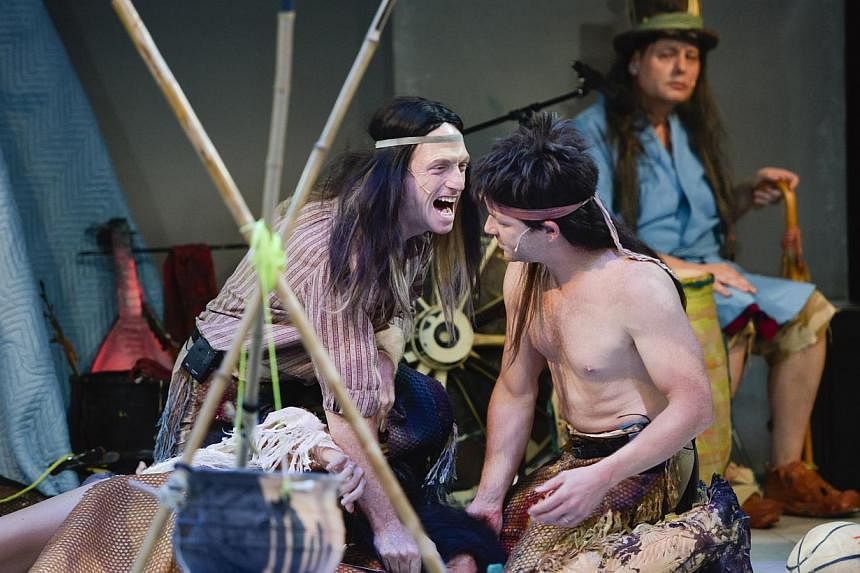Stupefyingly dull, offensive, and an insult to Shakespeare? Or a work that pulls the rug out from under every sacred convention of theatre?
Cry, Trojans! (which I might subtitle Cry, Unsuspecting Audiences!) is all of these things and more, a 2.5-hour determined trudge through the minefield of Troilus & Cressida, one of the Bard's most problematic plays.
Ostensibly about the doomed love story between the title characters from Troy, who pledge their love and then are ripped apart in two consecutive sets of betrayals (one political, one personal), the play is framed within a larger tale of betrayal of the Trojans by the Greeks, shunting aside the "protagonists" and initial bursts of ribald humour for a darkly violent, gloomy glimpse at war.
The Wooster Group shocked their American audiences with what seemed to be "redface", the blatant cultural appropriation of Native American history; the Trojans are styled as a fictional tribe, feathers and all, dressed in grungy traditional dress that, at first glance, might have been pulled off the rack from a used costume store, yet is morbidly striking - some of the warriors sheath themselves in busts of Greek statues, worn on their backs like scalped human trophies.
At the production's premiere in Stratford-upon-Avon, the Group horrified, even revolted, World Shakespeare Festival audiences, who derided the ensemble for poor acting and delivery and an utter disregard for text, and demanded "good theatre technique" and some sort of coherence. Many said they were connoisseurs of experimental theatre, but disdained this baffling experiment taking place in the heart of Shakespeare's hometown.
It is on this polarising final production that the six-week Singapore International Festival of Arts closes with a startling bang.
I myself emerged from theatre in slight delirium, with a bit of a tension headache and a churning stomach - but mostly from the prospect of looking at this production, piece by piece.
The work does not necessarily reward the patient. It is a demanding, challenging production, sometimes tedious and sometimes difficult to follow, and riddled with problems - the most basic of which involves having an all-white cast replicate, to the point of slapstick, Native American customs and culture. It is a dramatic device practically prostrating itself for controversy and criticism.
And yet I found myself inexplicably tugged along by the silent undercurrents of this conceptual melting pot.
Will the conqueror ever fully understand what oppression means to the conquered?
The Wooster Group is unabashed about this futility - no, we will never come to terms with the blood we have shed on Native American soil, and all we have left is a sort of play-acting within which we forcibly confine ourselves. The cast denigrates themselves, almost self-flagellatingly, before the stereotype of the Native American.
Director Elizabeth LeCompte has stated that the starting point for this work was Shakespearean English as a second language for many American performers; layered over that beginning are interruptions of historical baggage, technological innovation, and the Group's deliberate and fiercely single-minded pursuit of a perfection that only its ensemble seems privy to, every movement and declaration carefully calibrated to fit a larger and mysterious blueprint.
The School of the Arts Studio Theatre has been reshaped into a sort of version of the Group's Performing Garage in New York City, and its mostly bare stage is surrounded by television screens, with two DJs off to the side doing a live sound mix.
It quickly becomes clear that the cast are miming gestures from other films and video excerpts being played on these screens, whether in some sort of barren Inuit landscape, or the high melodrama of the likes of Elizabeth Taylor and Warren Beatty in glamorous Old Hollywood.
But which is which? Are the videos a simulacrum for the action on stage? Or are the gestures that are copied universal ones, to be read across circumstance and context? Some earn a chilling edge, when the glitz of leading Hollywood ladies flirting with their men is transposed onto the shocking delivery of Cressida into lecherous enemy hands. Others, when female cast members suddenly erupt into song, feel like a lazy gimmick.
But when these moments work, they gain a stark resonance: all that will be performed has already been performed, and history, in the same way, will mimic what has gone before. Troilus and Cressida use the same gestures of violence on each other as the Trojans do in their pow-wow over what to do with Helen: Return their prized princess to the Greeks and end the war? Or stubbornly keep her and their honour at the risk of bloodshed? They trade blows, they convulse, they tuck their hair behind their ears.
LeCompte shears off several scenes from the Greek camp, which mostly expound on the relationships between the Greeks, and focuses instead on the inner turmoil of the Trojan camp. The Greeks were initially played by members of London's Royal Shakespeare Company to maximize a clash of performance styles, but the work has continued to evolve since its premiere in 2012.
Now, The Wooster Group takes on all the parts, donning masks when they play the Greeks, with a doubling of parts that turns enemies into friends and heroes into villains. The same actor who plays the lovelorn Troilus (Scott Shepherd) also plays the cruel Achilles; he also plays Cressida's scheming father Calchas, who brokers her trade with the Greeks.
These multilayered characters seem to be a microcosm for the production itself. So much is at play in every scene: a deconstruction of the idea of acting, the repetition of movement across genres and art forms, the bursts of live, dubsteppy music, the echoes of recordings of previous iterations of the same production, a Mobius strip folding onto itself.
Conceptually, Cry, Trojans! is fascinating - but also the equivalent of painstakingly pulling apart a complicated metronome. Its inner parts may be gloriously and endlessly fascinating, but it always trots out the same rhythm.
It is almost as if the Group has created the machinery of a universe all to themselves, and I could not help but feel like a sidelined observer, only able to chip away at the surface of an automaton, its cogs and gears a-whirr. I puzzled over the actors' deliberate dispassion in delivering their lines, but was sucked in by the conscientiousness with which they sought to convey this devil-may-care attitude.
One thing is for sure - this is Shakespeare as you have never seen it, and might never see again, in a tide of ceaseless contradictions.
Follow Corrie Tan on Twitter @CorrieTan
book it
CRY, TROJANS! (TROILUS & CRESSIDA)
Where: School of the Arts Studio Theatre
When: Sept 19 and 20 at 8pm, Sept 21 at 3pm
Admission: $55 from Sistic (call 6348-5555 or go to www.sistic.com.sg)
Info: sifa.sg


